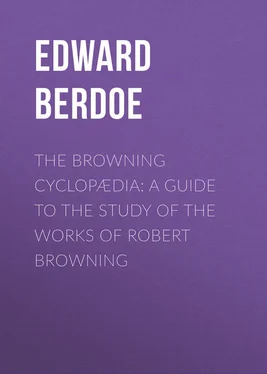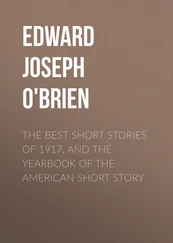Edward Berdoe - The Browning Cyclopædia - A Guide to the Study of the Works of Robert Browning
Здесь есть возможность читать онлайн «Edward Berdoe - The Browning Cyclopædia - A Guide to the Study of the Works of Robert Browning» — ознакомительный отрывок электронной книги совершенно бесплатно, а после прочтения отрывка купить полную версию. В некоторых случаях можно слушать аудио, скачать через торрент в формате fb2 и присутствует краткое содержание. ISBN: , Жанр: foreign_antique, foreign_prose, на английском языке. Описание произведения, (предисловие) а так же отзывы посетителей доступны на портале библиотеки ЛибКат.
- Название:The Browning Cyclopædia: A Guide to the Study of the Works of Robert Browning
- Автор:
- Жанр:
- Год:неизвестен
- ISBN:http://www.gutenberg.org/ebooks/36734
- Рейтинг книги:4 / 5. Голосов: 1
-
Избранное:Добавить в избранное
- Отзывы:
-
Ваша оценка:
- 80
- 1
- 2
- 3
- 4
- 5
The Browning Cyclopædia: A Guide to the Study of the Works of Robert Browning: краткое содержание, описание и аннотация
Предлагаем к чтению аннотацию, описание, краткое содержание или предисловие (зависит от того, что написал сам автор книги «The Browning Cyclopædia: A Guide to the Study of the Works of Robert Browning»). Если вы не нашли необходимую информацию о книге — напишите в комментариях, мы постараемся отыскать её.
The Browning Cyclopædia: A Guide to the Study of the Works of Robert Browning — читать онлайн ознакомительный отрывок
Ниже представлен текст книги, разбитый по страницам. Система сохранения места последней прочитанной страницы, позволяет с удобством читать онлайн бесплатно книгу «The Browning Cyclopædia: A Guide to the Study of the Works of Robert Browning», без необходимости каждый раз заново искать на чём Вы остановились. Поставьте закладку, и сможете в любой момент перейти на страницу, на которой закончили чтение.
Интервал:
Закладка:
The stone quarries of ancient Syracuse are now called Latomia, the largest and most picturesque of which is named Latomia de’ Cappuccini. It is a vast pit, from eighty to a hundred feet in depth, and is several acres in extent. Murray, describing these vast quarries, says: “It is certain that they existed before the celebrated siege by the Athenians, 415 B.C.; and that some one of them was then deep enough to serve for a prison, and extensive enough to hold the unhappy seven thousand, the relics of the great Athenian host who were captured at the Asinarus. There is every probability that that of the Capuchins is the one described by Thucydides, who gives a touching picture of the misery the Athenians were made to endure from close confinement, hunger, thirst, filth, exposure and disease. Certain holes in the angles of the rocks are still pointed out by tradition as the spots where some of the Athenians were chained. The greater part of them perished here, but Plutarch tells us that some among them who could recite the verses of Euripides were liberated from captivity.” Lord Byron’s lines in Childe Harold may be quoted in this connection —
“When Athens’ armies fell at Syracuse,
And fettered thousands bore the yoke of war,
Redemption rose up in the Attic Muse —
Her voice the only ransom from afar.
See! as they chaunt the tragic hymn, the car
Of the o’ermastered victor stops; the reins
Fall from his hands; his idle scimitar
Starts from his belt: he rends his captive’s chains,
And bids him thank the bard for freedom and his strains.”
“Some there were who owed their preservation to Euripides. Of all the Grecians, his was the muse whom the Sicilians were most in love with. From every stranger that landed in their island, they gleaned every small specimen or portion of his works, and communicated it with pleasure to each other. It is said that on this occasion a number of Athenians, upon their return home, went to Euripides, and thanked him in the most respectful manner for their obligations to his pen; some having been enfranchised for teaching their masters what they remembered of his poems, and others having got refreshments, when they were wandering about after the battle, for singing a few of his verses. Nor is this to be wondered at, since they tell us that when a ship from Caunus, which happened to be pursued by pirates, was going to take shelter in one of their ports, the Sicilians at first refused to admit her; but upon asking the crew whether they knew any of the verses of Euripides, and being answered in the affirmative, they received both them and their vessel.” (Plutarch’s life of Nicias.)
Notes. [The numbers refer to the pages in the complete edition of the Works.] – P. 5, Kameiros , a Dorian town on the west coast of Rhodes, and the principal town before the foundation of Rhodes itself; The League , the Spartan league against the domination of Athens. p. 6, Knidos , city famous for the statue of Venus by Praxiteles, in one of her temples there; Ilissian , Trojan; gate of Diomedes , the Diomæan gate, leading to a grove and gymnasium; Hippadai , the gate of Hippadas, leading to the suburb of Cerameicus; Lakonia or Laconica or Lacedæmon : Sparta was the only town of importance – in this connection it means Sparta; Choës (the Pitchers) an Athenian festival of Dionysus or Bacchus; Chutroi , a Bacchic festival at Athens – the feast of pots; Agora , the Athenian market and chief public place; Dikasteria , tribunals; Pnux == the Pnyx, the place of public assembly for the people of Athens; Keramikos , two suburban places at Athens were thus called: the one a market and public walk, the other a cemetery; Salamis , an island on the west coast of Attica, memorable for the battle in which the Greeks defeated the fleet of Xerxes, 480 B.C.; Psuttalia , a small island near Salamis; Marathon : the plain of Marathon was twenty-two miles from Athens, and the famous battle there was fought 490 B.C.; Dionusiac Theatre , the great theatre of Athens on the Acropolis. p. 7, Kaunos , one of the chief cities of Caria, which was founded by the Cretans. p. 8, Ortugia , the island close to Syracuse, and practically part of the city. p. 9, Aischulos == the song was from Æschylus, the great tragic poet of Greece; pint of corn : the wretched captives in the quarries were kept alive by half the allowance of food given to slaves. Thucydides says (vii. 87): “They were tormented with hunger and thirst; for during eight months they gave each of them daily only a cotyle (the cotyle was a little more than half an English pint) of water, and two of corn.” p. 10, salpinx , a trumpet. p. 11, rhesis , a proverb; monostich , a poem of a single verse; region of the steed : horses were supposed by the Greeks to have originated in their land. p. 12, Euoi , Oöp , Babai , exclamations of wonder. p. 13, Rosy Isle , Rhodes, the Greek word meaning rose. p. 16, Anthesterion month == February-March; Peiraieus , the chief harbour of Athens, about five miles distant; Agathon , a tragic poet of Athens, born 448 B.C. – a friend of Euripides and Plato; Iophon , son of Sophocles: he was a distinguished tragic poet; Kephisophon , a contemporary poet; Baccheion , the Dionysiac temple. p. 17, The mask of the actor : it should be remembered that the Greek actors were all masked. p. 20, Phoibos , the bright or pure – a name of Apollo; Asklepios == Æsculapius, the god of medicine; Moirai , the Fates – Clotho, Lachesis, and Atropos, the divinities of human life. p. 25, Eurustheus , king of Mycenæ, who imposed the “twelve labours” on Hercules. p. 26, Pelias’ child : Alcestis was the daughter of Pelias, son of Poseidon and of Tyro; Paian , a surname of Apollo, derived from pæan , a hymn which was sung in his honour. p. 27, Lukia == Lycia, a country of Asia Minor; Ammon , a god of Libya and Upper Egypt: Jupiter Ammon with the horns of a ram. p. 32, pharos , a veil or cloak covering the eyes. p. 35, Iolkos , a town in Thessaly. p. 41, Koré , the Maiden, a name by which Proserpine is often called. p. 47, Acherontian lake : Acheron was one of the rivers of hell; Karneian month == August-September, when the Carnean festival was celebrated in honour of Apollo Carneus, protector of flocks. p. 48, Kokutos’ stream , a river in the lower world: the river Cocytus is in Epirus. p. 51, Thrakian Diomedes , a king of Thrace who fed his horses on human flesh: it was one of the labours of Hercules to destroy him; Bistones == Thracians. p. 53, Ares , Greek name of Mars; Lukaon , a mythical king of Arcadia; Kuknos , son of Mars and Pelopia == Cycnus. p. 60, Lyric Puthian : musical contentions in honour of Apollo at Delphi were called the Pythian modes: so Apollo, worshipped with music, was called the lyric Pythian, in commemoration of his victory over the Python, the great serpent; Othrus’ dell , in the mountains of Othrys, in Thessaly, the residence of the Centaurs. p. 61, Boibian lake , in Thessaly, near Mount Ossa; Molossoi , a people of Epirus, in Greece. p. 68, Ludian == Lydian; Phrugian == Phrygian. p. 73, Akastos , the son of Peleus, king of Iolchis; he made war against Admetus. p. 74, Hermes the infernal : he was the son of Zeus and Maia, and was herald of the gods and guide of the dead in Hades – hence the epithet “infernal.” p. 78, Turranos , Tyrant or King. p. 79, Ai, ai! Pheu! pheu! e, papai == woe! alas, alas! oh, strange! p. 81, The Helper == Hercules. p. 83, Kupris , Venus, the goddess of Cyprus. p. 87, “ Daughter of Elektruon, Tiruns’ child ”: Electryon was the father of Alcmene, Tiryns was an ancient town in Argolis. p. 88, Larissa , a city in Thessaly. p. 94, Thrakian tablets , the name of Orpheus is associated with Thrace: the Orphic literature contained treatises on medicine, plants, etc., originally written on tablets, and preserved in the temple; Orphic voice , of Orpheus, which charmed all Nature; Phoibos , Apollo was the god of medicine, and taught the art to Æsculapius; Asklepiadai , who received from Phoibos or Apollo the medical remedies. p. 95, Chaluboi , a people of Asia Minor, near Pontus. p. 96, Alkmené was the daughter of Electryon: she was the mother of Hercules, conceived by Jupiter. p. 99, Pheraioi , the belongings of Admetus as a native of Pheræ. p. 110, “ The Human with his droppings of warm tears ,” a quotation from a poem by Mrs. Browning, entitled Wine of Cyprus . p. 111, Mainad , a name of the priestesses of Bacchus. p. 119, “ Straying among the flowers in Sicily ”: Proserpine, daughter of Ceres, one day gathering flowers in the meadows of Enna, was carried away by Pluto into the infernal regions, of which she became queen. p. 121, “ a great Kaunian painter ”: Protogenes, a native of Caunus in Caria, a city subject to the Rhodians, flourished 332-300 B.C., and was one of the most celebrated of Greek painters. “The story of his friendly rivalry with Apelles, who was the first to recognise his genius, is familiar to all.” — Browning Notes and Queries (Pt. vii. 25): the description of the picture refers to Sir Frederick Leighton’s noble work on this subject. p. 122, Poikilé , the celebrated portico at Athens, which received its name from the variety of the paintings which it contained. It was adorned with pictures of the gods and of public benefactors.
Читать дальшеИнтервал:
Закладка:
Похожие книги на «The Browning Cyclopædia: A Guide to the Study of the Works of Robert Browning»
Представляем Вашему вниманию похожие книги на «The Browning Cyclopædia: A Guide to the Study of the Works of Robert Browning» списком для выбора. Мы отобрали схожую по названию и смыслу литературу в надежде предоставить читателям больше вариантов отыскать новые, интересные, ещё непрочитанные произведения.
Обсуждение, отзывы о книге «The Browning Cyclopædia: A Guide to the Study of the Works of Robert Browning» и просто собственные мнения читателей. Оставьте ваши комментарии, напишите, что Вы думаете о произведении, его смысле или главных героях. Укажите что конкретно понравилось, а что нет, и почему Вы так считаете.












